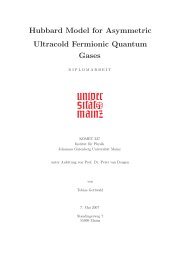5 Hirsch-Fye quantum Monte Carlo method for ... - komet 337
5 Hirsch-Fye quantum Monte Carlo method for ... - komet 337
5 Hirsch-Fye quantum Monte Carlo method for ... - komet 337
Create successful ePaper yourself
Turn your PDF publications into a flip-book with our unique Google optimized e-Paper software.
5.6 Nils Blümer<br />
(i) Imaginary-time discretization (β = Λ∆τ)<br />
(ii) Trotter decoupling (❀ systematic error O(∆τ 2 ))<br />
(iii) Hubbard-Stratonovich trans<strong>for</strong>mation (exact)<br />
Wick theorem:<br />
G =<br />
(iv) MC importance sampling over auxiliary Ising field {s} (❀ statistical error)<br />
Fig. 2: High-level overview of the HF-QMC approach.<br />
separated by use of the Trotter-Suzuki <strong>for</strong>mula [28, 29] <strong>for</strong> operators  and ˆ B:<br />
�<br />
{s} M−1 det{M}<br />
�<br />
{s} det{M}<br />
e −β(Â+ˆ B) = � e −∆τ Â e −∆τ ˆ B � Λ +O(∆τ), (10)<br />
where ∆τ = β/Λ and Λ is the number of (imaginary) time slices. 6 Rewriting the action (7) in<br />
discretized <strong>for</strong>m<br />
AΛ[ψ,ψ ∗ ,G,U] = (∆τ) 2�<br />
σ<br />
�Λ−1<br />
−∆τU<br />
l=0<br />
�Λ−1<br />
l,l ′ =0<br />
ψ ∗ σl (G−1<br />
σ )ll ′ψ σl ′<br />
ψ ∗ ↑lψ↑l ψ∗ ↓lψ↓l , (11)<br />
where the matrix Gσ consists of elements Gσll ′ ≡ Gσ(l∆τ − l ′ ∆τ) and ψσl ≡ ψσ(l∆τ), we<br />
apply (10) and obtain to lowest order<br />
exp(AΛ[ψ,ψ ∗ ,G,U]) =<br />
Λ−1 �<br />
l=0<br />
� �<br />
exp<br />
(∆τ) 2�<br />
�Λ−1<br />
σ<br />
l ′ =0<br />
× exp � −∆τ U ψ ∗ ↑l ψ ↑l ψ∗ ↓l ψ ↓l<br />
ψ ∗ σl(G −1<br />
σ )ll ′ψσl ′<br />
�<br />
� �<br />
. (12)<br />
Shifting the chemical potential by U/2, the four-fermion term can be rewritten as a square<br />
of the magnetization (in terms of operators: (ˆn↑ − ˆn↓) 2 = ˆn 2 ↑ + ˆn2 ↓ − 2ˆn↑ˆn↓ = ˆn↑ + ˆn↓ −<br />
2ˆn↑ˆn↓) which makes it suitable <strong>for</strong> the following discrete Hubbard-Stratonovich trans<strong>for</strong>mation<br />
[30] (the correctness of which is checked easily by inserting the four possible combinations<br />
[(0,0),(0,1),(1,0),(1,1)] of eigen values of the associated density operators):<br />
�<br />
∆τU<br />
exp<br />
2 (ψ∗ ↑lψ↑l −ψ∗ ↓lψ↓l )2<br />
�<br />
= 1 �<br />
exp<br />
2<br />
sl=±1<br />
� λsl(ψ ∗ ↑lψ↑l −ψ∗ ↓lψ↓l )� (13)<br />
6 Since β = 1/kBT is the inverse temperature, small ∆τ on each “time slice” corresponds to a higher temperature,<br />
<strong>for</strong> which the operators effectively decouple. Thus, we may view the Trotter approach as a numerical<br />
extension of a high-temperature expansion to lower temperatures.













